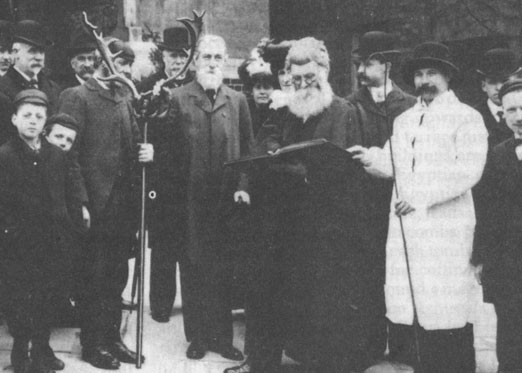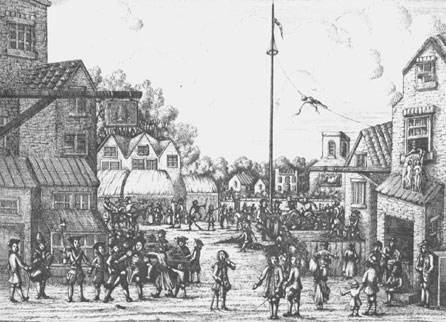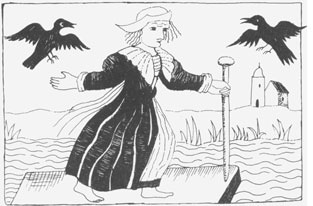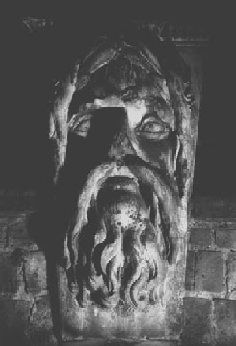Co-editors: Seán Mac Mathúna • John Heathcote
Consulting editor: Themistocles Hoetis
Field Correspondent: Allen Hougland
|
The Gaia Counterpart: The Green Man The Green Man and the Green Woman The Lodge of Herne: Herne the Hunter Resource List A Survey of the History of English Place Names Greenwood's Map - List of Place Names
|
 Swearing on the Horns, Highgate, 1906. Described by Bryon in Childe Herald, there were once about 20 public houses in Highgate, where strangers were required to take a pair of antlers horns in their hands, and swear a jocular oath:. . . Both men and maids are sworn, Historical backgroundThe Pagan fertility god Herne the Hunter/the Green Man was one of the main gods of the ancient Britons from Paleolithic times. Chesca Potter, writing in her pamphlet Mysterious Kings Cross (Mandrake, Oxford, 1990), says that the Stag-headed God represents: The male fertilic power of nature, physically and spiritually. In prehistoric times, the Shaman would have dressed in deerskins and a mask with stag-horns becoming as the God . . . There is enough evidence to say that the Green Man/Herne the Hunter is well connected with certain areas of London: We have the Horn Fair - still held in Charlton village every year; the connection in the early history of Greenwich with fertility rites, stag worship and the Green Man; the possibility that Herne Hill is named after him, indeed, did the hill have a greater significance to the Stag-worshipping Celts of early London ? There is also the Pagan temple dedicated to the Goddess Diana which once stood on the site of St. Paul's Cathedral, reputedly built by the legendary King Brutus who Diana appeared to in a vision in Malta and urged him to settle in "the great white island" - Albion some 3,000 years ago. He landed at Totnes in Devon and marched on London where he erected the temple of Diana - on which he recorded details of his vision of the Goddess of the Stag and Archery. This Pagan temple survived until the arrival of the Saxon's in the 7th century when St. Pauls Catherdral was first built. Thus, it could be argued that the worship of the Horned God and the Stag Goddess arrived with King Brutus and stayed an integral part of the religious life of Celtic Londoners right up the first suppression of Paganism in London in the 7th century A.D. However, the Pagan rites of Celt's of London have survived well into recent times with the May Day festivals, the May Pole celebrations, and other festivities connected with the Green Man/Herne the Hunter. In medieval times, for example there was at least four major May Day festivals - often lasting well over a week: in May Fair (Mayfair), the Southwark Fair, the Greenwich Fair, and the Horn Fair from Bermondsey to Charlton. Finally, there is also a belief that the Isle of Dogs is named after Herne's 50 dogs, identified by their red tipped ears, and known as the Hounds of Hell. It is highly possible that the worship of the Green Man in Celtic times and beyond, was centered around Greenwich and the Isle of Dogs, although today there is scant evidence of this, except in the place names. The ancient legends connect the Robin Hood/Green Man stories with Wimbledon Common and Windsor Castle, and possibly other areas of London through pub names: l notice there's a Herne's Tavern on Peckham Rye Common, one called The Horns in St. Pancras, the Horn Tavern in EC4, the Green Man in Bellingham etc. The Horned God also has Germanic origins which were brought over by Pagan tribes such as the Angles and the Saxons to Britain from the 4th century onwards. Perhaps one of the reasons why stag workship has survived so long in most parts of Britains is that the Saxon tribes were themselves Pagans and no doubt contributed substantially to the survival of both the folkore and stag worship up until present times. One of our readers, Penda, from Germany, e-mailed me (March 2001) with the following information on the origins of stag worship in Britain (read the full text of his letter here): The stag played an extremely important role in the Germanic witchcraft traditions. The god Yngvi Freyr's sacred animal was the stag, and he used a stag horn to slay the giant Beli. One of the tribes that invaded Briton were called the Ingavones, whom were a tribe that was dedicated to Yngvi Freyr. Rituals surrounding Yngvi Freyr were very "shamanic" oriented. They did shaking/swaying dances with small bells sewn into their tunics. Other Inveonic rituals involved wildly dancing around boar heads, as well as dressing up in boar skins and wearing stag horns. Evidence of the Pagan Saxons in London can be found in the fact that the Germanic Pagan God Tiw was the God of Law - who gave his name to Tues-day. One long forgotten river in London was named after him: the River Tyburn, which now flows mainly underground from it's source in north London. Oxford Street was once, for example, called Tyburn Road until 1713 when Edward Harley, the 2nd Earl of Oxford bought up the area and had the street named after him. The place commonly known as Tyburn is where Marble Arch is today, and was London's main execution site from 1388 until 1783. As condemned prisoners had the right to make a final speech this is the origin of Speakers Corner - where anyone can exercise the right of free speech free from the threat of libel laws (like in Parliament itself). Furthermore, it is an established fact that the River Tyburn (which flows near Marble Arch), splits right where Buckingham Palace is today and forms an island called Thorney Island, on which law making and such like was traditionally carried out according to pre-Roman Celtic tradition. There, was apparently, once a Druid tree college on the site. The fact that it is the site of the British Parliament and the seat of government is another connection with Pagan times long since forgotten in London's official history. May Day Festivals in LondonAnother part of the worship of the Horned God was the celebration of fertility in the festival of May Day. These happened in May Fairs held in Greenwich and the area in central London known today as May Fair. In fact, there was once two fairs in Greenwich, on the Monday, Tuesday and Wednesday of both Easter and Whitsun week, with the Easter celebrations being the best known. A time honoured custom at the Greenwich May Day was for young couples to climb the hill to where the Royal Observatory is today, and then run or roll down the hill to the great excitement of the gathered crowds. One wonders how old the effigy of the Horned God in Jack Cade's Cavern under Maidenstone Hill in Greenwich is ? Indeed, whether the ancient cave was also the site of initiation rites connected with the Horned God.  The May Fair in London, c. 18th century. Note the May Pole in the picture. Mayfair in London takes its name from the May Day fair that was held there until its suppression in the 18th century. It was held every year on May 1st for 15 days, rivaling the present day Notting Hill Carnival which only lasts for 2. Originally held in Haymarket, in 1686-8 it was moved to Great Brookfield - now the site if Curzon Street and Shepherd Market. There is other evidence in place names such as Hornsey in North London, Hornchurch in Essex. If the area had such strong connections with the Horned God and his pack of dogs, then this would make sense. We also have Mayfair - once the site of May Day celebrations until it was suppressed in 1764. There was also a May Fair in Greenwich until it was also suppressed in 1870. Until 1718, there was a 134 ft May Pole by the Church of St. Mary in the Strand in central London. We also know that the Church of St. Helen in Bishopsgate is built on the site of a Pagan temple probably connected with the Horned God, as the writer Chesca Potter says that the early Celts regarded St. Helen as the consort of the Horned God. St. Paul's Cathedral is also built on a Pagan temple dedicated to the worship the Goddess Diana, who was closely connected with Stag worship. Like with the Swearing on the Horns in Highgate, a similar ceremony survived at St. Paul's until the turn of the century: the head of Stag was brought into the Church by clergymen and laid on the altar, and which point, huntsmen from the forests surrounding London, blew their horns at the four quarters. This was followed by "great feasting and celebrations" according to John Matthews and Chesca Potter writing in The Aquarian Guide to London (The Aquarian Press, London, England, 1990). The Horn FairThe Horn Fair was an ancient festival - more like today's Notting Hill Carnival - which started at Cuckold's Point in Rotherhite and paraded down the streets through Deptford, across Deptford Bridge, through Greenwich and up to the ancient site now where Charlton House in south London. For more on this festival, click here. Early Celtic LondonThis early history of Celtic London is completely ignored in most history books of the city for whom London emerged as a city either after the arrival of the Romans or at the time just before the Norman invasion. The Battle of Hastings in 1066 saw the triumph of the Norman invaders, but before then the last most significant date before the Saxon invasion was in 410 AD, when the Romans left Britain, and Celtic rule established. In London and Kent at least, this would last for some 200 years after the departure of the Romans. This l consider worth mentioning, as l would assume from this, that worship of the Horned God in London and the South-East of Britain would have been widespread before the Saxon's drove our Celtic forebears from the area around 560 AD (even though the Celts by this time were largely Christians and the Saxons were Pagans). Thus, we can assume that from historical records, that London was Celtic (and therefore largely Welsh-speaking) until at least the 6th century AD. Evidence that worship of the Horned God was still widespread in the 7th century is found in an edict issued by the Pope in 669 AD. He had been forced to send a mission to southern England and led by Theodore the Greek, who became the new Archbishop of Canterbury. One of his first actions was to issue a series of laws that forbade pagan practices. One of the most famous of these concerned the wearing of animal masks and costumes during the Twelve Days of Yule: Whoever at the kalends (first) of January goes about in the form of a stag, that is changing himself into the form of an animal, dressing in the skin of a horned beast, and putting on the head of a beast, for those who in such wise transform themselves into the appearance of a wild animal, penance for three years, because it is devilish. The English language arrived after the Jutes, Saxons and Angles (who later gave their name to this land: England from Land of the Angles or Angland) conquered most of the island of Britain. Although the Celts were driven out from most of what we call England today, they succeeded in maintaining their language and independence in Cornwall, Wales and Cumbria, by and large until after the arrival of the Norman's in the 11th century. Before we look at the evidence of worship of the Horned God in Celtic Britain before the Saxon invasion, we should look at the historical background of these events. In 410 AD, the Roman Empire no longer considered Britain to be a colony, and Roman officials were expelled and a native government established. At this time, southern Britain was being constantly raided by Saxons, Irish and Picts, according to Peter Berresford Ellis, writing in Celt and Saxon: The Struggle for Britain AD 410-937. (Constable, London, England, 1993). Between 425 and 450 AD, the High King of Britain of southern Britain is now known to have been Vortigern (from Vawr-tighern or Overlord), was the ruler of the southern half of Britain around 450 AD. Known by the Celts of Kent as Gwrtheyrn Gwrthenau or "supreme Leader" , he became the arch-traitor in the Celtic kingdom, as he is accused of betraying Britain to the Saxons. It is worth speculating whether Vortigern had any connections with Greenwich, which until the end of Celtic times had a greater magical significance than it does today, with its Great Seat or Gorsedd on Blackheath Common, the Maze on the edge of the Common (from where Maze Hill gets it name), and the areas connection with the Horned God, May Day and fertility worship. The Great Seat (now known as Whitfield Mount) may have been a place where the High-King of Kent attended meetings or took part in rituals that celebrated the Winter and Summer Solstice. Vortigern employed Jutish mercenaries to help fight the Saxons who were attempting to establish settlements in Kent. However, in 449 AD, these mercenaries rose in mutiny, led by Hengist and Horsa. By 465 AD, the Jutes managed to breakout of their settlement on Thanet Island (from the Celtic word meaning "the bright island"), and begin their conquest of Kent. By 488, Aesc, the son of Hengist, had been crowned King of Jutish Kent. This was followed in 495 AD, when the Saxons began to establish a kingdom near Southampton. It is unclear when Greenwich and London fell to Saxon rule, but this would have been around 560 AD, as the Saxons began in invade mid-Britain in 571 AD. We know that Vortigern fought one battle on the River Darent in Kent (the Celtic name means "The River by the Oaks"), with other battles being fought between the Jutes, Saxons and the Celts at Aylesford and Crayford (Cray coming from the Celtic word "fresh or clean"). The Saxon chronicles at the time claimed to have killed 4000 Britons, and that the "British forsook Kent and fled to London"). However, the Celts regrouped and defeated the Saxons at Richborough in 460 AD, where some say that Vortigern was killed in his hour of triumph. It seems that following this battle, a new Celtic leader emerged in southern Britain, known in the Welsh tradition as Emrys (the historian Gildas referred to him as Ambrosius Aureliannus). He led a another successful counter-offensive against the Saxon invaders. Emrys made a prophecy that the Red Dragon (the Celts) would triumph over the White Dragon (the Saxons). However, it was to be the Saxons who had conquered most of the island of Britain by the 7th century AD. By the time Aesc became King of Kent in 488 AD, Berresford Ellis observes that: The indigenous Celtic population (of Kent), the descendants of the Cantii who gave their name to the area (and Canterbury), and were the first to face the landings not only of Julius Caesar but of Aulus Plautius one hundred years later, had either been massacred by the new (Saxon) settlers or driven westward out of the area; a few perhaps had been retained as Slaves by the Jutes to be absorbed eventually in their German culture . . . (p41). Historical evidence presented by Berresford Ellis indicates that the Saxons and Jutes pursued "a policy of annihilation" against the native Celtic population of Kent in the 6th century AD. The Saxon's engaged in "clearing the native inhabitants" from their lands, which would eventually become England. The Celts of Kent and southern Britain, worn down by "two centuries of raiding" were "virtually exterminated". In Sussex, for example, very few Celtic place names survive, showing a "fairly immediate and complete change of population" (Celt and Saxon, p43-44). By the end of the 6th century AD, the Saxon's controlled London (from the Celtic Londo, meaning "a wild place"). The Saxon King Aethelberht of Kent exerted his authority over the city, having been converted to Christianity by Augustine in 597 AD, and had the first Saxon Church built there in 604 AD at St. Pancras Old Church, itself built on a Pagan sacred site on a small mound beside the River Fleet (now a underground sewer). Aethelberht also built over the main Pagan site connected with Stag worship in London - St. Paul's Cathedral , completed in the same year. Thus, we have evidence that the Saxon's obliterated the Celtic places of worship and other places of cultural importance after they had driven the Celts from London.  The Witch of St. Pancras: Shown here crossing the Fleet River with Old St. Pancras Church in the background. From a printed printed by John Hammond in 1643 entitled "A Most Certain, Strange and True Discovery of a Witch". In 1968, the Beatles used the Church graveyard for the inside shot of their double album The Beatles: 1962-1966. Thus, the advent of Christianity and Saxon rule probably saw the end of the worship of Herne the Hunter in the area, although the tradition of May Day and the Horn Fair has survived through to the present day. Herne the Hunter in South-East BritainSeveral writers, such as E. O. Gordon, Jack Gale, John Matthews and Chesca Potter, have all highlighted Greenwich's much older history - that of being a site of great significance to our Celtic forebears in pre-christian times. I was always intrigued by it's name the "Green Village", with it's possible connections to earlier May Day festivals, and the Horned God, Herne the Hunter, commonly known in this part of Britain, as The Green Man. Thus, it is clear that the Pagan history of Greenwich and Deptford goes back into the mists of time where all that survives today are folklore, myth and legend. Few would now accept that the old city of London and the Kentish villages (as they were then) of Greenwich and Deptford had no history before the Roman occupation in 43 AD. The Green Man, who in the Celtic myth was known as the King of the Underworld, was known by many names in Celtic Britain: as Arawn as he rides over Pembrokeshire; as Gwyn ap Nudd as he hunts between Glamorganshire and the West country; while further east, he appears as Herne the Hunter. He is always accompanied by his white hounds, which have the tell-tale red-tipped ears of dogs of the underworld, according to Caitlín Matthews, writing in Mabon and the Mysteries of Britain (Arkana, London, 1987, p23). I believe that that worship of Herne was a strong religious practice among the early Celts of this area of South East London in pre-christian times (England was declared a Christian country under the Saxon Kings in 665AD). St. Paul's Cathedral in London was a site originally dedicated to the worship of the Stag Goddess, Diana. According to the Annals of St. Paul's (1879), St. Paul's Cathedral was a site of a temple - probably a stone circle - until the Aethelberht had it destroyed and the site rededicated as a Christian site between 604AD and 610AD, as noted in 1879 by John Murray in the Annals of St. Paul's (Quoted in Hell, Volume Two, May 1994. Alan Moore and Eddie Campbell, Kitchen Sink Press/Mad Love Publishing, MA, USA, 1994. However, it takes a long time for people to forget or lose religious practices which are thousands of years old. The investigative writers Alan Moore and Eddie Campbell state: "The continuation of clearly Diana centred rituals at St. Paul's until almost a thousand years after the alleged ascendancy of Christianity is documented in John Stone's Survey of London (1598), in which he tells how a buck and a doe (Diana's sacred animals), would be slaughtered at the high altar upon a certain date each year, after which the head would be paraded about the cathedral upon a pole while horns were blown to announce the sacrifice, these being answered by horn blasts from every quarter of London. Commentators at the time remarked: 'It seems we have our Diana worship back' ". In Windsor Park, people still claim to have seen Herne the Hunter or heard his dogs calling out through the mist. These ghostly appearances are said to be seen when Britain is under threat, for example, just before the Second World War. According to Eric L Fitch, writing In Search of Herne the Hunter (Capell Bann, Berkshire, England, 1994, p161), the last time it was reported seen was by a soldier guarding Windsor Castle in 1976. Matthews and Potter also claim that the Isle of Dogs - which was a combination of forest and marshland until quite recently - is haunted by a ghostly huntsman riding through the sky with a pack of phantom hounds. In their view, it is probable that Herne the Hunter was once worshiped on the island, and his "presence" still lingers there. A carving of a head that resembles the Green Man can be found above an old entrance to a house bordering Greenwich Park in Park Vista: It shows his head with the leaves and bushes growing out of his mouth, nostrils and ears - a common representation of the Green Man (see picture). 
Picture by David Somerset, 1997 The Herne myth is closely interwoven with the Robin Hood legends. Areas connected with him in London, such as Wimbledon Common and the Kingston Zodiac which surrounds it, contain places named after him, such as Robin Hood Gate and Lane in Wimbledon, and Robin Hood Lane in Millwall, according to Mary Caine writing in The Kingston Zodiac (published in Kingston, Surrey, England, 1978). Greenwich Park, which researchers believe at one time, had at least one stone circle and several underground initiation sites, is undoubtedly an ancient and sacred site. When the park was enclosed in 1433, a stretch of ancient roadway, which was believed to have been part of the old Roman Watling Street, was closed to public use. (Other Meridians, Another Greenwich, Adelphi, London, England, 1994, p 22). ConclusionThe evidence presented here supports the hypothesis that the early Celtic inhabitants of London worshipped the Horned God, and that the Pagan celebration of fertility in the May Day festivals survived until quite recently in the city with the May Fair near Tyburn (Marble Arch), and the Greenwich Fair. Rituals connected with worship of the Stag Goddess Diana, and the Horned God, also survived until quite recently with the Swearing on the Horns in Highgate, and the Blowing of the Horns in St. Paul's Cathedral. Along with place names and local legends connecting the Horned God or Green Man with the Isle of Dogs and Richmond Park, these suggest that these beliefs and religious worship was once widespread in Celtic London and the surrounding areas, and probably only began to die out with the Saxon conquest on London in the 6th century AD. © 2000 |
|
|
|